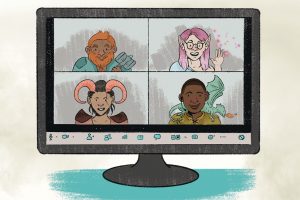
The game begins with ominous background music and an occasional, startling thunderclap. Molly Virello, head of children’s services at Southington (Conn.) Public Library (SPL) narrated part of one of her one-shot adventures: “Behind a cage, you see a giant, armored shark with legs the size of a horse. It has jaws that look big enough to swallow you whole…. The door flies open! And the bulette—” a massive dog-like shark creature in Dungeons & Dragons, a tabletop dice-rolling role-playing game—“rushes out at you. Roll for initiative.”
At “Critical Hit! Table Top Gaming in the Library,” a January 28 session at the American Library Association’s 2023 LibLearnX conference in New Orleans, Virello shared how to run a Dungeons & Dragons session for new players, including basic game terminology and what library workers should consider if they want to start their own program.
A veteran player of the game, Virello had long been thinking of hosting a Dungeons & Dragons program at her library, but it wasn’t until a parent approached her that she realized the true need of it. “Our middle schools used to have [Dungeons & Dragons] clubs, and they were so popular that kids would be on wait lists to join,” she said. But once the pandemic hit, the clubs stopped running. Though local game shops and comic book shops hosted sessions, the parent told Virello that they were hard to break into and players were mostly adults. So, in summer 2022, Virello began a program at SPL where patrons aged 10–14 could participate in a beginner-friendly Dungeons & Dragons game.
As a new dungeon master (or, the person who organizes and runs the game and guides players through its story), Virello didn’t want to dive into the complex and often intimidating traditional “campaign” format of Dungeons & Dragons, which can take an entire day or more to finish. Instead she opted for one-shot adventures, or self-contained games that could be finished within an hour or two. She also provided basic, preset character sheets so that new players didn’t have to be concerned with the long process of creating characters. And rather than the often scarily drawn monsters in traditional Dungeons & Dragons games, she used cuter versions that had less severe or violent consequences in battles with players’ characters.
Virello emphasized the most important thing when playing Dungeons & Dragons, especially for first-timers, is to have fun. Hosting shorter, pared down one-shots instead of longer, multiple-session campaigns makes the experience more accessible. She said she has often heard participants talk about their experiences to their families after sessions, and added, “After one game, all of my players exchanged phone numbers because a player’s older brother was going to run a campaign for them.”
And for library workers who are considering being a dungeon master or running a Dungeons & Dragons program for the first time, Virello advised: “It helps you to understand that we’re all just making stuff up as we go along. Yes, there are rules, but that doesn’t always have to apply. Your job is to make sure everybody’s on track and the game is fun.”


